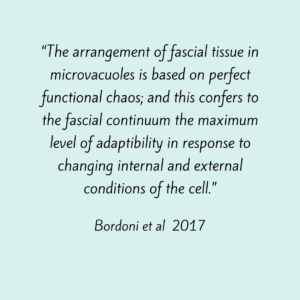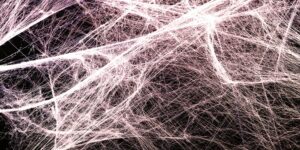The fascinating world of fascia
- In Fascia

Fascia is the body-wide internal network of connecting membranes that forms an architectural framework for all other structures within our bodies. This network is also fluid, elastic, and, most interestingly, alive.
Fascia has long been the frustration of anatomists dissecting human bodies for medical study. It wraps and packs everything so densely that cutting it away to get to the actual muscles and organs is quite the effort. Beyond its function as basic packing material, recent research on living fascia has enlightened us as to how much more it actually does for us.
Fascia the great connector
On a global scale, fascia is the basic tissue that holds the skeleton together. Without fascia, our skeleton would be a pile of random bones. Every joint is surrounded by a dense joint capsule and several ligaments holding it together and reinforcing it in the directions of high tensional load. These peri-articular fascial structures merge with the intra-articular structures inside the joint. For example, the menisci (shock-absorbing discs) within the knee joints merge with the ligaments and other fascia surrounding the joint. Additionally, every bone is wrapped in fascial membranes that merge with surrounding muscular membranes.
Fascia connects the muscular system with the skeletal system. Every single muscle fibre is wrapped in fascia, and individual segments of muscle fibres are wrapped in fascia. All these fascial wrappings inside a muscle merge at its end to become the tendon that attaches the muscle to the bone.
This is not the only way a muscle is connected. Each muscle is surrounded by fascial membranes that connect it to all other muscles and bones that lie around it in its three-dimensional space. The connective fascia surrounding a muscle is known as its myofascial expansion, and every bit of tension the muscle produces is transferred via these expansions to all the muscles around it. This is how muscles communicate and coordinate their functions. Muscles are connected in functional groups called myofascial meridians (by Tom Myers, Anatomy Trains), and these connections allow muscles to produce whole-body movements and help each other out when one of them is injured, rather unceremoniously called “compensation”.
The nervous system spreads out from the brain and spinal cord in a wide network of peripheral nerves throughout the body. The circulatory system spreads through all details of the body in a similar way. Nerves, together with blood and lymph vessels, travel in tunnels created by fascia, and their branches spread out to muscles within the spaces between them. In this way, fascia is the scaffolding that channels all blood and lymph vessels through the body. The physical structure of nerves and blood vessels themselves is made up of fascia, and this merges with the fascial membranes containing them. In this way, fascia connects the brain to the rest of the body, for movement control and sensory feedback. The fascial membranes that hold nerves can actually conduct electrical nerve signals (and produce some of their own), thereby extending the reach and function of the nervous system in our bodies.

Fascia helps us slide through life
Our movements are created by the force produced by contracting muscles. However, no movement would ever take place if these muscles were not able to slide past each other as they contract. All inner structures have to be free to move and slide as the whole body continually changes its position, and this sliding capacity comes from the hydrated fascial membranes between them. Healthier fascia is more hydrated and allows more freedom of movement, while unhealthy fascia becomes sticky and restricts the freedom of structures to slide, creating stiffness and limiting movement. Good blood supply and nerve function also depend on this sliding freedom, as nerves and vessels also have to adapt to all movements.
Fascia is a fluid medium
The microscopic structural framework of fascial membranes is created mainly by collagen fibres, providing tensional strength and structure, and elastin fibres, providing elastic recoil and bounce to our mechanical systems. But at least 70% of fascia is fluid. The fluid component is held by glucosaminoglycans (GAG’s) – molecules that bind water and hold it in place, like chia seeds forming a jelly-like substance when you soak them in water. In fascia, this jelly-like substance is called extra-cellular matrix (ECM). Together, the structural fibres held within their jelly-like ECM create an adaptable fluid medium that has both tensile strength and viscoelasticity – the ability of fascia to deform and adapt according to mechanical circumstances.
It is the capacity of fascia to hold water that allows it to be a sliding membrane for freedom of movement. This is also necessary for shock absorption, as the impact of a fall is spread across the body through hydrated fascia to reduce damage at the impact site. Together with elastin, the hydrated fascia creates a viscoelastic substance that absorbs shock within joint spaces, helps our muscles save energy and protects our joints from overstretch via elastic recoil. When our fascia loses its capacity to hold water, our bodies become stiff and prone to injury.
Fascia adapts to movement
The idea that fascia is arranged in layers that slide over each other helps us to understand how healthy fascia is essential for freedom of movement on a global scale. However, recent research is shows that, on a microscopic level, fascial tissue is not really arranged in layers, but rather in polyhedral units of microfibrils called microvacuoles, that change shape under internal or external tension.

This fascial tissue surrounds each cell in our body, and provides a medium for all cell processes. It is through this medium that all nourishment (nutrients, oxygen) and communicative chemicals (hormones, neurotransmitters, etc) travel from the blood stream to the cell, and it is through this medium that all metabolic waste products are cleaned up by the lymph system. It is also within this medium that inflammatory and regenerative processes take place, and it makes sense then that all these processes, essential to the basic function of each cell, are highly influenced by the mechanics of the fascial tissue that houses them.
As scientists discover new methods of enquiry, more detail is uncovered. In 2018, the medical world was excited to announce the discovery of a new “organ” in the body: the interstitium. It is a network of fluid-filled spaces within connective tissue that had not been visualized on standard types of microscopic imaging before. We now know that this is the same as what we describe here under the general term ‘fascia’, and scientists like Bruno Bordoni and his colleagues are continually redefining what fascia is and does, based on the newest discoveries.
Since fascia is present within and around each and every other structure in the body, it is perfectly situated to coordinate communication between them. It is also independently responsive to tensional changes in the system, adapting and changing the way the entire system is arranged to give us an independently functional unit, capable of adapting to mechanical challenges. Beyond a passive structural role, fascia is a complex system, alive and responsive to changes in our inner and outer environments. Our fascia integrates all parts of our bodies, allowing us to live as a whole; as a fully integrated self-regulating system, continually adapting to the world as we move through life.
Detailed structure
Image credits:
Fascia 1: https://fasciatrainingacademy.com/what-is-fascia-2/
Fascia 2: https://blackroll.com/article/what-are-fasciae
Fascia 3: https://akronmassage.co/2021/01/23/fascia-the-tangled-web-our-bodies-weave/
Fascia 4: https://functionalfascia.com/whats-it-all-about/fascia-facts/
Fascia 5: https://www.thethinkingpractitioner.com/e/22-gil-hedley/
You may also like

